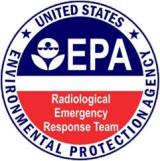Radiological Emergency Response
EPA prepares for, and responds to, emergencies involving radioactive materials. EPA's Radiological Emergency Response Team (RERT) works with federal, state and local agencies to monitor radioactivity![]() radioactivityThe emission of ionizing radiation released by a source in a given time period. The units used to measure radioactivity are becquerel (Bq) and curie (Ci). and clean up affected areas. During an emergency, EPA uses its protective action guidelines to help determine what actions are necessary to protect people from unhealthy levels of radiation.
radioactivityThe emission of ionizing radiation released by a source in a given time period. The units used to measure radioactivity are becquerel (Bq) and curie (Ci). and clean up affected areas. During an emergency, EPA uses its protective action guidelines to help determine what actions are necessary to protect people from unhealthy levels of radiation.
Related information in Spanish (Información relacionada en español)
Planning and Past Responses
To prepare for a radiological incident, EPA has plans and procedures that are tested and practiced in exercises on a regular basis. EPA has extensive knowledge about radiological emergency response from experience with real-life emergencies. Learn more EPA's radiological emergency response planning and EPA's role in past responses.
Expertise and Equipment
EPA has on-scene coordinators and several special teams that focus on responding to environmental emergencies, including the Radiological Emergency Response Team (RERT). The RERT provides specialized support for radiological or nuclear emergency responses. Learn more about EPA's radiological emergency response expertise and equipment.
Response Authorities
From "dirty bombs![]() dirty bombA mix of explosives, such as dynamite, with radioactive powder or pellets. Also known as a radiological dispersal device (RDD). A dirty bomb is not a nuclear weapon." to foreign radiological releases, EPA has the ability and authority to respond to many different types of radiological incidents. When other federal, state, or local organizations lead responses to radiological emergencies, EPA provides a supporting role. Learn more about radiological emergency response authorities.
dirty bombA mix of explosives, such as dynamite, with radioactive powder or pellets. Also known as a radiological dispersal device (RDD). A dirty bomb is not a nuclear weapon." to foreign radiological releases, EPA has the ability and authority to respond to many different types of radiological incidents. When other federal, state, or local organizations lead responses to radiological emergencies, EPA provides a supporting role. Learn more about radiological emergency response authorities.
Protective Action Guides
The Protective Action Guide (PAG) manual contains radiation![]() radiationEnergy given off as either particles or rays. dose guidelines that would trigger public safety measures, such as evacuation or staying indoors, to minimize or prevent radiation exposure during an emergency. EPA developed Protective Action Guides to help responders plan for radiation emergencies. View and download information about EPA's Protective Action Guides (PAGs).
radiationEnergy given off as either particles or rays. dose guidelines that would trigger public safety measures, such as evacuation or staying indoors, to minimize or prevent radiation exposure during an emergency. EPA developed Protective Action Guides to help responders plan for radiation emergencies. View and download information about EPA's Protective Action Guides (PAGs).
EPA also responds to oil spills, chemical, biological, radiological releases and large-scale national emergencies. Learn more about EPA's role in emergency response.

